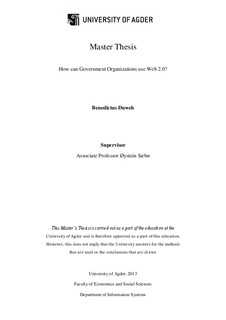| dc.description.abstract | Over the past few years, most government organizations have been using e-Government and m-Government successfully with few difficulties along the way. These two forms of governments provide a solid foundation for government organizations to take the next step by becoming more participative, and engage citizens on various social media channels because most of their information and services are already digital. There are several existing research on the use of social media by organizations, most of which focus on businesses. Even though there are some similarities between the public and private sectors there are also several differences. And because of these differences, there is a theoretical and practical need for research focusing on how government organizations can use Web 2.0. The aim of this thesis is to understand how government organizations are using social media or Web 2.0 in their respective organizations while filling in the gap basing on related findings, to propose how they should use Web 2.0. Using social media can be complex, there are several advantages like democratic participation and engagement, co-production; but there are also disadvantages or challenges like privacy concerns and untrustworthy content. Organizations need to be able to handle these challenges as well as realize the full potential and benefits for using social media platforms or channels. Due to the fact that there is very little existing research on how government organizations can use Web 2.0 or social media, the complexity of social media and the many different social media applications and participative factors to take into consideration, I investigated in two stages to truly understand the subject area. 1) A literature review was conducted basing on 43 articles that were placed in a concept matrix to create an overview of the subject area as well as to ensure a balance on relating topics. 2) 10 qualitative semi-structured interviews were conducted in 5 different government organizations: a university, the road administration, labor and welfare administration, county governor’s office and the regional council. All informants involved in this research were responsible for several social media aspects within their respective organizations. This research proposed a DOM Framework that illustrates how government organizations can use Web 2.0. The DOM framework consists of: four Key Mechanisms and three main categories. The Key Mechanisms are: Planning, Stakeholders, Transformation Area and Evaluation. And the three main categories are Demand-pull, Operations and Management, where each first letter in the main categories is represented in DOM. Basing on the DOM framework; I concluded by suggesting that government organizations can use social media by going through three stages while using the Key Mechanisms to positively influence and support the three stages. The first stage is the Demand-pull where organizations establish their reasons for using social media and the reasons that will encourage participants or users to return. They should also be able to select the social media applications that will support their goals, decide how they will participate in terms of information sharing or cross-agency collaboration and finally understand the underlying technologies that will ensure customization, integration or further development when needed. Stage 2, Operations ensures that the organization understands the various social media activities of their selected applications. In short what can be done, for example comments, links. Stage 3, Management suggests several elements and activities that need to be managed. For example who will be doing the monitoring, what information they will share, privacy issues, social media strategies, etc. all of which needs to be managed. The Key mechanisms are supposed to be used to influence and support the three main categories or stages. For example planning can be used on every aspect and ensure that all strategies are align. | no_NO |
